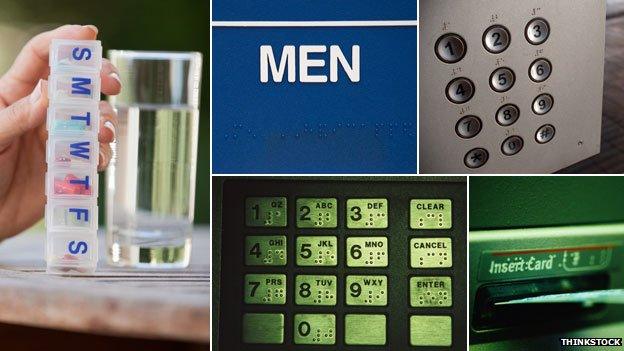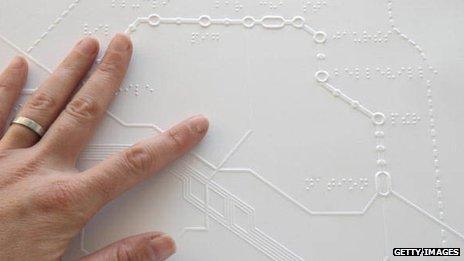Braille is spreading but who's using it?
- Published
- comments

Thanks to changed regulations Braille is spreading but do most blind people actually use the language of dots?
It's been around for 200 years but you may only recently have noticed Braille in everyday usage.
If you've had your eyes, or fingers, open, you may have noticed Braille on toilet doors to denote gents or ladies, on buttons in lifts, on bottles of wine and packaging on breakfast cereals and ready meals.
The Co-op chain spearheaded this small revolution on some of their own brand products but it's appearing gradually on other goods in other stores too.
Braille menus are available on request in many UK chain restaurants such as Nando's and Pizza Express, but it's most obvious on medicine and pharmaceuticals - everything from cough sweets to blood pressure tablets.
Across Europe, it's all thanks to an EU directive passed in 2005. But the trend is not restricted to Europe.
On Twitter, you'll regularly see US users pondering why there is Braille on drive-through cash machines when blind people can't drive. They can be passengers, of course.
In the not-too-distant past, Braille on bleach bottles used to have paternalistic messages like "irritant" or "do not drink" rather than giving useful information about what the product was, like "kitchen surface cleaner".
There has been a shift in the attitude of supermarkets and other key businesses, says Pete Osborne, chief Braille officer at the Royal National Institute of Blind People (RNIB).
"Manufacturers don't now say 'it'd be really nice if we could do Braille' they say we know we should, we need to know how."
But there's a contradiction - as Braille use spreads across everyday objects, the number of people using the system has actually been in long-term decline.
Louis Braille came up with the system - drawing inspiration from a failed military "night writing" code - while still a child in France in 1821. It allowed blind people to read independently for the first time and was widely adopted.
At the time, raised dots were the best hope for blind people. Today there are screenreaders for computers as well as smartphones that speak. It has spawned a generation of blind people who are tech savvy out of necessity.
So, in this talking digital landscape, are lumps in paper still useful? And how many people are still using the medium?

A Braille map of the Paris Metro
Fewer than 1% of the two million visually impaired people in the UK are users of Braille. "The best figure we have is 18-20,000," says Osborne. "That's people who use Braille in some context.
"This could represent people who have enough Braille to recognise or play a game of dominoes or cards or read basic 'uncontracted' Braille on paracetamol, right through to those who learn from Braille music and play to professional level."
Of the two million with sight loss, the majority are over 65 years old. And of that group, Braille users tend to be those who have not been able to see from an early age.
Only 2,000 people regularly order books from the Braille library, which suggests the majority use it only for more practical reasons.
Despite being head of the Braille coding group at the UK Association for Accessible Formats, James Bowden would rather listen to an audio book for leisure purposes than pick up a Braille book.
The Braille version might consist of half a dozen encyclopaedia-sized volumes. Bowden sees Braille as being better at fulfilling an immediate need for information than for fun.
"[When] labelling CDs, playing a game of Scrabble or cards. If you don't know what a CD is, you'd have to put it in your player. With 20 CDs, it could take you 20 minutes to find the one you want to listen to."
A Braille "cell" consists of up to six dots, almost like a domino. It's not too difficult to learn all 26 letters, but the difficulty comes in the touch and building up your reading speed. A letter S and a letter T, for instance, feel very similar to someone who hasn't yet "built up their touch".
MP and former Home Secretary David Blunkett was regularly seen at the dispatch box reading his statements in Braille. "It's a slow medium. It's necessary, I'm very grateful for it, but I would say that a reasonably fast print reader is twice as fast as I am," he says.
"I'm a good reader to myself, I am not an easy reader to an audience and so I tend for my speeches to have just notes which I refer to as background which is why I found making full carefully drafted statements at the despatch box difficult.
"I used to hate it. Answering questions in Parliament was a doddle compared with that - for very many politicians it's the other way round."
Blunkett urges people to learn Braille saying that even the best computer Braille displays and earpieces won't help you do a presentation in the same way as having your information on paper in front of you.
There's always the threat of batteries running out or a device breaking, and US studies have suggested Braille users are more likely to find work because they have a "greater grasp of literacy", Osborne says. In the UK today, 66% of blind or partially sighted people of working age are unemployed.
The move to listening to computers with speech synthesisers rather than experiencing full words, letter by letter, underneath your fingertips, means that words are often heard without necessarily knowing how they're spelt. In turn, this can make writing more of a challenge for some users. Braille displays connected to computers largely solve this literacy issue but are sometimes prohibitively expensive.

A Braille Playboy magazine, for blind musician Ray Charles
Before the middle of the 19th Century, reading the Bible was a bigger motivation than employability for Braille teachers, says Philip Jeffs, archivist at RNIB's National Library. But with the advent of Braille typewriters in the 1890s blind people could then do clerical work.
The RNIB produces Braille, but it doesn't teach it directly to individuals. Local authorities have tended to organise the teaching, funded by government.
But there is a funding mismatch, says Osborne. Not enough people are taught to use Braille, particularly when compared with the volume of Braille material produced.
"There is a global problem in developed countries," says Osborne. "Traditionally organisations have spent vastly more on producing and storing it than teaching it. UK, Spain, France, US, Australia. It's a problem that needs to be addressed.
"Our view is that people should have the right to learn Braille if they want it."